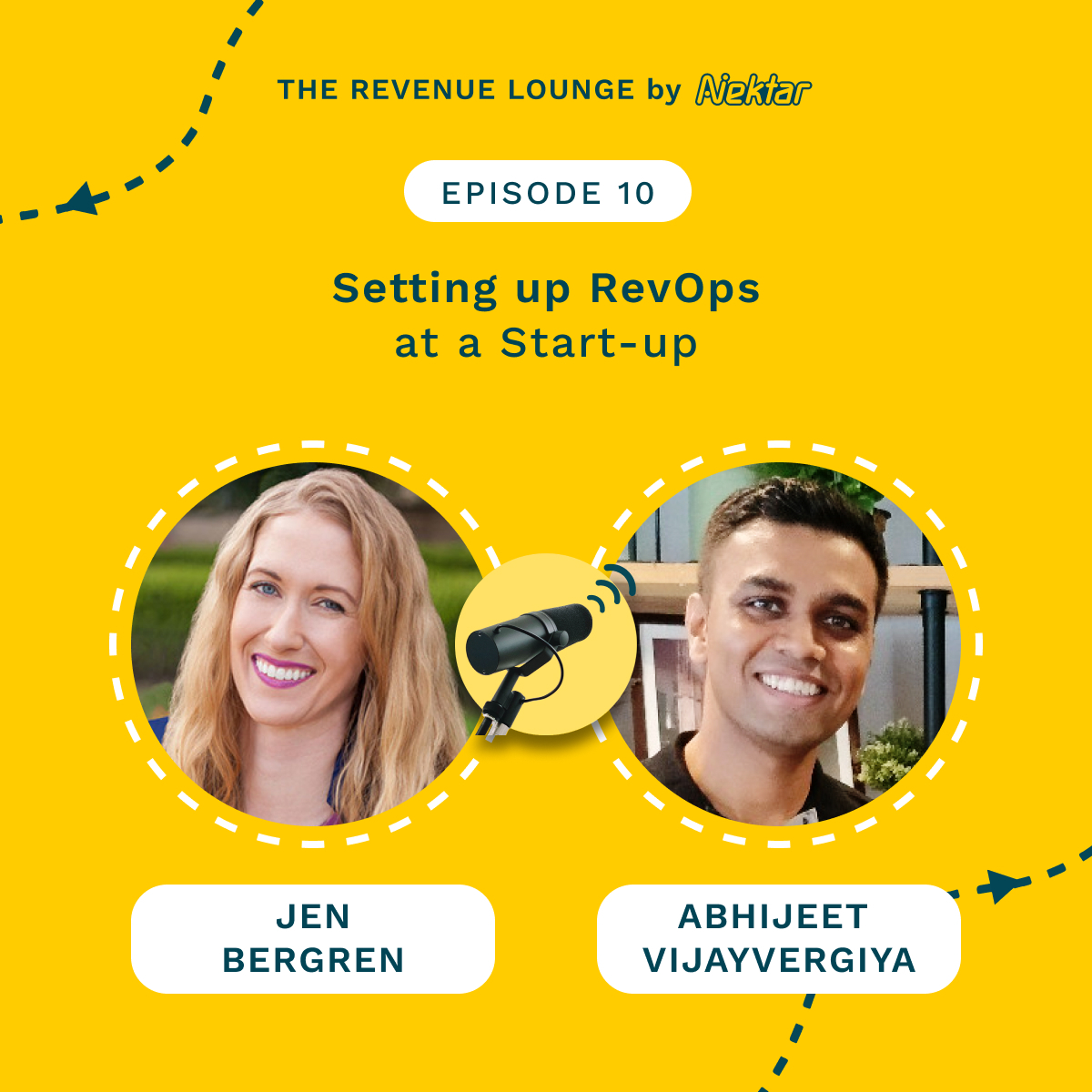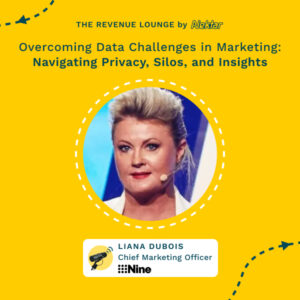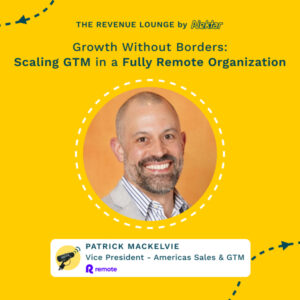Creating a Strategic Partnership Between Sales & Customer Success ft. Jagroop Gill
April 10, 2024
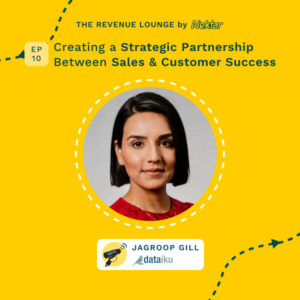
About
The Revenue Lounge
The podcast covers stories from leaders across RevOps, Sales, Customer Success, GTM, Data and Marketing about what drives these functions and what advice they would share with our listeners. With 3 seasons recorded, the podcast currently features 50+ enterprise leaders in the B2B SaaS domain. Tune in to hear from the best in the business
In this episode of the Revenue Lounge podcast, host Randy Likass interviews Jagroop Gill, Director of Enterprise Customer Success at Dataiku. They discuss strategies for aligning sales and customer success teams to drive revenue growth.
Key topics include:
– Breaking down silos and friction points between sales and customer success
– Leveraging data and insights across teams
– Metrics to understand customer health and growth opportunities
– Advice for customer success professionals
Main Discussion Points:
– Common friction points between sales and customer success (misunderstanding roles, operating in silos, lack of relationship transition) [00:02:48]
– Customer success strategies to enable sales team growth (intellectual curiosity to identify expansion opportunities, conveying business impact) [00:07:08]
– Metrics to convey customer success value (retained revenue, net dollar retention) [00:23:19]
– Adopting sales methodologies (MEDDIC, challenger) to set up renewals and mitigate risk [00:27:47]
– Key attributes for customer success managers (intellectual curiosity, business acumen, technical acumen) [00:10:48]
Guest Bios:
– Randy Likas: Host of the Revenue Lounge podcast.
– Jagroop Gill: Director of Enterprise Customer Success at DataIQ. 4+ years at DataIQ managing high growth customer portfolio. Previously an Enterprise CSM at the company.
Key Quotes:
“Really understanding the so what is so important. Because when your sales team is going to seek a broader investment, these data points are going to help reinforce the sale.” [00:08:22]
“If you’re looking to take a risk, especially in your career, and you have a backup plan or you have, like, a soft landing that you can land on if this doesn’t work out, then it’s not a risk.” [00:30:44]
The alignment between sales and customer success has become more crucial than ever. Today, we’ll unravel the secrets to creating a seamless collaboration between these two departments. How can sales and customer success teams work hand in hand not only to acquire customers, but also ensure their long term satisfaction and loyalty? And how can they leverage data and insights to contribute towards a sustainable revenue growth strategy? Hello, everyone
[00:00:50] Randy Likas: Welcome to the Revenue Lounge podcast. I am your host, Randy Lykis. And joining me today is Jagroop Gill. Jagroop is the director of enterprise customer success at DataIQ. Jagroop has years of leadership experience in forging strong alliances between sales and customer success teams.
[00:01:06]Randy Likas: Hi, Jagroop. Thank you for joining us today.
[00:01:07]: Jagroop Gill: Thank you so much for having me. It’s a huge pleasure to chat with you today. Was really looking forward to this conversation.
[00:01:13] Randy Likas: Yeah. Me as well. Let’s start the discussion maybe just by telling us a little bit about your current role at Dataiku and what your journey’s been so far up to this point.
[00:01:21] 2: Jagroop Gill: Yeah. For sure. So I’ve been at Dataiku for a little over 4 years. It’s the longest I have been, at any company, which I feel like is a big feat for a millennial. I joined as an enterprise CSM, and I think that’s been a huge asset and a huge privilege to my role as a leader because I’ve quite literally walked the same path that my team is walking today.
00:01:41 Discussion with Jagroop Gill about Leading the US Northeast Region
[00:01:41] 2: Today, I lead our US northeast region, so I have about 8 direct reports. And I believe we have the largest customer portfolio in terms of customer accounts and revenue in the Americas, and we’re one of the highest growth regions, in the entire company. So it’s a really cool role. We support our enterprise and strategic customers, and our team is responsible for driving adoption, mitigating risk, and supporting our sales team with growth in our accounts.
00:02:09 Managing Friction Between Sales and Customer Success in Growing Companies
[00:02:09] Randy Likas: It certainly sounds like a big role and one that I think is probably pretty challenging. Right? What we’ve often found is there’s been a friction with sales and customer success along the customer journey. It’s certainly gotten a lot better, I think, this year as more and more organizations are are leaning on customer success to help drive revenue. But I was wondering if you could maybe talk about, historically, how you’ve dealt with that friction that’s always seems to exist between the two groups.
[00:02:33] 2: Jagroop Gill: Yeah. For sure. I’d say early in my career or early stage companies, I actually found the friction was a lot less. And I think it’s because when you have a small team, Everyone’s a little bit scrappy. Everyone’s a stakeholder, and everyone just pulls through to get the job done.
[00:02:48] 2: So even if there was blurring their lines, no one really cared because there was this organic mesh of, we do everything to make the customer and the company successful. I really started seeing the friction points as the accounts got larger, the company got larger, and growth started happening a lot faster, growth in terms of customers and growth in terms of the company. And there were, like, a few common points that I found where this friction occurred. One was not really understanding the role of customer success. This especially happened when you had salespeople who came in or sales leaders who came in, who worked at companies where the definition of CS was a little different.
[00:03:23] 2: And I would get feedback such as, why isn’t your team driving an upsell, or why isn’t your team troubleshooting this issue? And it was truly just a misunderstanding and a misalignment of what customer success did and what sales did. And we also found that salespeople expected, you know, the account closes, it’s handed over to CS, I never have to touch it again, and they would go off and work on other accounts, and and that really inhibited collaboration. So really just not understanding the role and the objectives was the first one. The second big friction point, and I found that sometimes this existed early stage as well, is sales and customer success operating in silos.
00:04:00 Syncing Sales and Customer Success Teams for Improved Customer Experience
[00:04:00] 2: Right? And you would actually think that’s the exact opposite of friction. These people aren’t touching at all. But that creates a lot of issues for the customer. Right?
[00:04:07] 2: So think about us as end users. If we go to Hudson’s Bay, which is a big Canadian department store, and I were to buy things from the beauty department, and the household department, and the clothing department, when I log into my account, I want to see, like, a comprehensive history of my life cycle as a customer, right, regardless of where I shopped. Similarly, our customers really don’t give a hoot on who CS is or who sales is. They want a comprehensive experience. So if we’re launching in different directions and we’re not connecting internally, it’s going to be inefficient, and we’re going to give our customers a bad experience.
[00:04:40] 2: Where I’ve seen this happen quite a bit is when we’re offering proposals to customers that that customer success hasn’t been part of, commercial proposals, or we’re sometimes calling into the same teams. And this hasn’t happened in a long time, but I have had experiences where sales and CS are calling into the same teams, sometimes telling them different things, and they’re coming back and saying, can you guys please get your ducks in a row? Because this is not the enterprise experience we paid for.
[00:05:06] : Jagroop Gill: And then I’ll say in this economy, one of the really big ones has been bad transfer of pre to post sales knowledge or relationships. We have seen some experiences where sales can be extremely guarded over these executive relationships. And this was something that one of my early career mentors told me, is that sales often is going to be guarded with their buyer relationships. Because often, throughout their careers, they’ve gone back and sold to the same people, different technologies to the same people. And if CS doesn’t have those same exact relationships or that same exact alignment, in times like this year where purse strings are a little bit tighter and budgets are tighter, we introduce a high level of risk.
[00:05:48] 2: And when we look at some of the risk that we experienced this year, not just in my company, but other network colleagues that I have, a lot of it has come down to stakeholder alignment. Right? So if we’re not doing a proper transition of technical knowledge, reasons for buying, or even a lot of these executives are making decisions, I think we’re introducing a lot of risk and creating friction among the account team.
[00:06:11] Randy Likas: Absolutely. I I don’t think you could have said it any better. We see the exact same thing, but when we talk with our customers around that, I wanna unpack each one of these a little bit further. Just ask some some follow-up questions. So the first one is Yeah.
00:06:24 The Role of Customer Success in Driving Upsell Opportunities
[00:06:24] Randy Likas: Understanding the role of customer success. And oftentimes, in many organizations, it’s not clear who actually owns the upsell opportunity. The success person might identify it. And in some organizations they own it. In other organizations, they pass it over to the account manager.
[00:06:40] Randy Likas: And I think it all starts from understanding who owns the commercial relationship or who owns not just the initial sale, but driving that. So what role does success play in helping drive upsell for you today?
[00:06:50]: Jagroop Gill: That’s a really good question. I think the answer is more that, like, success is more of a correlation type relationship rather than a causation. There’s different types of growth that happen on the account. Right? There’s organic growth that happens when adoption’s really high, you identify new users, and the customer says, hey, we’ve used up all our licenses, and we want a few more.
00:07:08 The Value of Customer Success in Driving Growth
[00:07:08] Jagroop Gill: And that’s very easy to say, hey. Success contributed to that. We were able to get every single butt and every single seat, and now there’s more buts, so they need more seats. Right? I find that when you’re looking at very strategic customer success, it’s in some cases, you can define the impact.
[00:07:26] 2: In other cases, it’s harder. Where I see success really making an impact is very clearly identifying the company’s strategic goals and how they align to technology, and working with the customer, not just to achieve those goals, but also articulate and measure the impact. Right? So if the organization’s mission is to save $500,000,000 and buying this technology is part of that, Understanding where the major cost drivers are in your organization, how this technology can help alleviate that, what the net savings were, and then what the net impact was to the business. Right?
[00:08:05] 2: So it’s not just we saved this, but now that we’ve saved this, what does this mean for your organization? Does this mean you’re meeting your objectives? Does it mean you can now invest in other areas? Does it mean you’ve opened up capacity to generate revenue in other ways? So really understanding the so what is so important.
[00:08:22] 2: Because when your sales team is going to seek a broader investment, these data points are going to help reinforce the sale. And once again, in this market, those data points are important.
[00:08:32] 2: I think another area where CS really adds value and growth is running really in-depth discovery, and I call this intellectual curiosity. Right? I always say there’s 3 key pillars that I measure in or or 3 key attributes that I measure in a CSM, and one of them is what I call intellectual curiosity. So that’s the ability to really dig in and run discovery. So if a team is coming to you and saying, hey.
[00:08:54] 2: You know, we’re a modeling team, and we often work with this production team over there, and we need to send models to them. Being able to dig in and say, who is that production team? What do they use? What are they working on? And then being able to build almost like what we call an expansion plan, where you’re starting to now map out what are other teams we can break into, what do we know about them.
00:09:15 Key Qualities of a Customer Success Manager
[00:09:15] 2: Jagroop Gill: And having this consolidated record, then we can then send over to sales and say, here’s the intel that I was able to gather based on my relationships. Maybe you should go call into them. And I would say that’s not a 100% the organic growth, but it’s not really strategic growth. It’s, like, somewhere in between. Right?
[00:09:31] 2: Where you’re just throwing a lead over to your sales counterpart.
[00:09:34] Randy Likas: Yeah. But I think what that also does, and it kinda gets into your second point as well, is when customer success is working in a strategic manner like that where they are digging into the curiosity and trying to understand that and do a little bit more of discovery, that’s adding value to the salesperson that maybe they couldn’t get otherwise. Right? So a lot of times when a salesperson is trying to land a deal, they’re reading 10 k’s. They’re reading quarterly reports.
[00:09:56] Randy Likas: They’re looking at whatever they can find online of maybe executives speaking at conferences. But there’s only so much you can find that’s sort of publicly available as opposed to once you’re in there and you’re learning from the executives. Right? So I think that’s a key component of helping break down some of those silos of, hey. My customer success person is actually adding value to me as I try to expand my account.
[00:10:16] Randy Likas: Right? And so that’s part of that. I wanted to also just give you an opportunity. I think you said there’s 3 things that you look for in a CSM. So one was the intellectual curiosity.
00:10:22 Discussion on Essential Skills for Customer Success Professionals
[00:10:22] Randy Likas: What were the other ones?
[00:10:24] Jagroop Gill: I would say the other 2. What I like to call, like, business acumen or CS acumen, and that to me is the ability to really navigate through a large enterprise. Right? So my customer success career has always been in the advanced analytics AI space. So what I look for is, does this person know how to identify the difference between an IT admin versus, like, a data strategy person versus an enablement team?
[00:10:48] 2: Like, do you know how to navigate a large enterprise and leverage all these relationships to your benefit? Right? And also part of that on our side is, do you know how to run a success plan? Do you know how to, identify the customer’s goals? Do you know how to build an adoption plan?
[00:11:02] 2: So really just understanding the CS motions from our perspective, but also navigating through the company. And then the second is a technical acumen. I firmly believe that customer success needs to understand their product and needs to be able to translate the customer’s technical needs. I do not believe customer success needs to be a data scientist or an engineer, and I have worked in environments where data scientists were considered customer success, and those customers were enabled, but was there value realization? Was there a lot of strategic growth on those accounts?
00:11:38 Key Skills for Technical Sales Professionals
[00:11:38] Jagroop Gill: No. I think we had really burnt out salespeople on those accounts. So there needs to be a technical acumen where you can understand how does the customer’s technology needs align with their business goals or or their technology investment and usage align with their business goals. How can we translate their needs internally to make sure that they have the right resources? Also, do you have enough understanding of their tech ecosystem and tech stack that you can identify opportunities for risk or growth.
[00:12:07] 2: Right? So for example, when we have server based installations, right, and I’m probably dating myself here, but, like, when you look back at Hadoop installations, I recently spoke to a relative of mine who’s like a 3rd year engineering student, that when I mentioned Hadoop, he thought it was, like, a relic of the past. Like, it didn’t exist anymore, which I thought was hilarious. But when you think about, like, Hadoop installations or even cloud installations, do you know enough about the surrounding ecosystem where you can say, this configuration is going to create a bad user experience? And because it’s my software’s UI, the end user is going to see, there’s going to be a misconception that this bad experience is due to the software and not due to the back end configuration.
[00:12:50] 2: Mhmm. So can you pick up on things like this that will impact the customer’s health? Then the third was intellectual curiosity. Can you connect the dots? Can you read between the lines?
[00:13:01] 2: Can you establish trust and really, you know, pull that intel out to add value, not just to your salesperson, but to the broader account team and organization.
00:13:10 Effective Post-Sales Engagement Strategy: Aligning Pre and Post-Sales Teams
[00:13:10] Randy Likas: Yeah. I actually think that’s really good way to look at it and couldn’t agree with you more. If a customer success person has those 3 capabilities, they’re going to drive value back to not only organization, but the salesperson to help them drive more expansion opportunities. The area where I wanted to dive into next is the bad transfer between pre and post sales. And I do understand that the sales reps are sometimes guarded with their relationships, but oftentimes, it comes down to, are we working from the same sheet of music as far as, like, who is involved in the sales process, who had the influence, like, navigating the buying cycle so that when you start to delivery or your team knows when they start delivering against this, like, who the key stakeholders are.
[00:13:50] Randy Likas: And maybe some of those people roll off. Right? As they were involved with the buying decision, but they’re not involved moving forward. And so how do you work to understand I guess, reunderstand the key stakeholders that are part of the project after the the contract has been signed?
[00:14:04] 2: Jagroop Gill: I think one thing that I’ve seen done really well is offering a standardization of this process and not saying that you have to follow it. Like, my leader often says, work with the template, don’t let the template work you, which I think is really well put, where it’s like, offer them some guidelines around, here are the key people, right, that we often look at, and this is your influence. And some of these roles might be merged into the same person, and some of these might be a little bit more diversified. So I think really navigating through what are some of the key roles, and then what purpose will they serve post sales? So I found when I was a CSM, what I would often ask my sales counterpart was, who’s the person who’s ultimately signing on the dotted line?
[00:14:55] 2: Who’s the person who’s designing the strategy around how this particular technology or data is flowing through the organization? And who’s responsible for adoption, and really outlining how my interaction with these roles and how these individuals will help the account be successful long term. Right? And then part of this process was also mapping out what sales is owning, what customer success is owning, what services is owning, so that you’re almost instilling this trust in the broader team that this is how and why these relationships are useful. This is what I’m doing versus what you’re doing, and constantly reinforcing that this is the most efficient way for us to manage the account.
[00:15:35] 2: Right? Because, ultimately, if this account renews, you’re being measured on how to grow this account, and our services team is being measured on, you know, using up their hours within a certain number of time. Mhmm. So taking a step back, I think what’s really important here is, as a leadership team, offering some guidance. Right?
[00:15:52] 2: And not just expecting the team to run with it on their own. But then as a cross functional team, really making sure that we all understand what our missions and objectives are, and how they contribute to this joint success we’re all driving towards around keeping your customer and making them a bigger customer.
[00:16:10] 2: And I think, like, again, taking a step back, that’s really on leadership to define that and then reinforce that within their team.
00:16:17 Challenges in Team Alignment and Overcoming Friction
[00:16:17] Randy Likas: It’s a challenge even in today’s world. It sounds like your team is a little bit more mature, but getting that alignment, or do you feel that it’s been a journey so far and your team’s pretty well established or mature, I should say, on sort of what that process looks like?
[00:16:28] 2: Jagroop Gill: I think we were on a good trajectory for a while. I think I know, like, when you talk about software adoption, they talk about crossing the chasm. Right? There’s, like, the people who do really good, and then there’s this, like, big gap, and you have to, like, jump over the gap to really escalate.
[00:16:43] 2: I think we got to a point where we hit that gap because we just grew so quickly. And I’ve I’ve seen this happen multiple times, and when I talked to to other friends in in the industry, when you bring on a lot of people all at once, you’re bringing them on for their experience, and you’re trusting and hoping that their onboarding is gonna be really quick because these are experienced people who have done this a 1000000 times before. But with that also comes their own preconceived notions of how an account team should run. And when there’s a huge market opportunity, a lot of growth, a lot of people coming on at once, you don’t always have that time to acclimate them to your way of doing things. Mhmm.
[00:17:17] 2: So we definitely did hit a bit of a rough point. And and I’ve seen it before, and thankfully because I’ve seen it before and and others are going through the same thing, we were able to cross it. But it really did require, like, a recalibration. Mhmm. And I think one thing that’s really helped here is, as a leadership team and even as individual contributors, your cross functional colleagues are your team as well.
[00:17:42] 2: Right? It should. And I think what’s always helped me is I’ve never looked at my sales RVPs as a different team. Right? I’ve always looked at them as my peers.
[00:17:51] 2: We’re coming together, and we’re driving towards joint success. And I think when there is friction, when there are challenges, assuming positive intent and coming to the table with solutions rather than identifying problems, I think helps a lot. So coming together and saying, hey, there’s clearly a gap here where we’re not understanding what we’re supposed to be doing. And I had a conversation like this with a colleague recently where a salesperson was very guarded about an executive relationship, where he came forward and said, I think this is putting a lot of undue stress on your team member. I think they’re burning a lot of cycles with these interactions because these are actually success related things that should be done.
[00:18:31] 2: And based on my assessment, this is how much of their time is being absorbed or what percentage of their capacity is being absorbed. Let’s figure out where this misalignment or mistrust is. Bring it over to my team. I will lean in a little bit to make sure that my team is supported to own this relationship, but let’s free up your guy to bring in more revenue.
[00:18:51] Randy Likas: Yep.
[00:18:52] 2: And my counterpart was like, this makes complete sense. I don’t know why we’re not already doing this. Like, yes. Let’s get to it.
[00:18:58] Randy Likas: Yeah. I I think when it comes down to, you know, once we land a client, you’re absolutely right. We are one team. Right? We may represent different areas of the business, but our main job is to service this client and to grow this client and to make sure that that they’re happy.
00:19:11 Exploring the Role of Data in Sales and Customer Success Silos
[00:19:11] Randy Likas: And so by all means, we should be operating as one team just serving sort of different purposes. The one thing that we haven’t talked about so I understand sales and CS silos in the context that we’ve been discussing so far have been operation silos, right, in terms of how we work. I’d be curious to see how what role data data plays into these silos. Right? I’ll give you an example.
[00:19:30] Randy Likas: I think most reps typically work out of CRM to manage their opportunities, and they’re not the best at updating the the information, updating who’s all coming in as part of the in and out of the deal, who’s got influence, so on and so forth. But that’s the system that they primarily use. And oftentimes sometimes CS doesn’t even have access to that. Or if they do, they’re looking at the opportunity record and going, it’s kind of bare. Right?
[00:19:52]Randy Likas There’s not a lot of context here. And you talked a little bit about having a sort of a template that you use to guide you. Where does that template live? Is that a separate system? Do you use a CS tool?
[00:20:01] Randy Likas: Like, just wanna understand a little bit more on the data piece and how you collaborate on the data.
00:20:05 Aligning Sales and Customer Success for Effective Collaboration
[00:20:05] Jagroop Gill: This is such a good question. And I’ll be honest, I haven’t seen it done perfectly yet. I think CS tools are really good and really powerful, But CS tools can create silos if they’re not implemented properly because I have seen and and I won’t name the tools because I don’t wanna give them bad press because they are good tools. But I have seen, like, really good implementation of CS tools, but bad output because sales doesn’t have access. Right?
[00:20:30] 2: I think we are getting better in centralizing in one CRM, but then there will be, like, offshoots around adoption data or usage data that sits specifically with customer success. And what has worked well is creating, like, very active collaboration and communication across the teams. So even though we will have access in some situations to the same data via Salesforce, what we’re extracting or what we’re reporting will be different. Right? So for example, my sales counterpart is often reporting out his declarative forecast.
[00:21:10] 2: Sometimes he’s talking about his GLAR, like his gross loss ARR, but he’s mostly looking at what he’s selling. Right? Whereas, what I’m forecasting is how much down sell and churn do I think we’re gonna have, and what’s our renewal rate, and what renewals we have out. So I think that’s been a really good situation where we have access to the same data. We’re reporting out different things based on what our team’s working on, but I’m making sure that I have a weekly report that I get out to him.
[00:21:35] 2: So I send out a weekly report that says, here’s how we’re sitting in terms of renewals for this quarter and my forecast to the end of the year. Here’s where we’re sitting in terms of our actual downselling churn and what our forecast is this quarter and to the end of the year. And here is what our upsell forecast is at. And our our upsell forecast, I pretty much take from him because that’s really his domain.
00:21:56 Metrics and Alignment in Customer Success
[00:21:56] Jagroop Gill: But I found that, like, actively reporting those out and communicating is important. And then also, we have an NDR goal as an organization. So I’ll forecast out based on what we know on these three categories that I just listed above. Here is where I think our NDR will end up, and this is, like, the dollar gap to our goal. So he then knows what he would need to fill with his team.
[00:22:21] 2: But I think some data points will just stay outside in terms of adoption and things like that. And I think that’s where connecting as a team and making sure we’re communicating becomes very important.
[00:22:32] Randy Likas Yeah. Absolutely. Let’s turn this a little bit to metrics. You’re starting to touch on that a little bit, which is the KPIs to to understand the health of a customer or success of a customer or growth. NDR, I assume, is a pretty important metric because you mentioned that.
[00:22:45] Randy Likas: What are some of the other metrics that your team follows to help make sure that you’ve got no risk, I guess, for renewals or limited down sell insurance? And what are some of that I mean, that’s good. Like, leading into indicators and and lagging indicators?
[00:22:57] Jagroop Gill: That’s a good question. I think that’s something that’s still a work in progress. I’ve seen scorecards established really well that are more like red, yellow, green. Scorecards around, adoption, around technology risk in terms of, like, what’s their setup like, stakeholder engagement. So I would say that those have been good leading indicators.
[00:23:19] 2: I do believe that NDR is more of a lagging indicator because it’s it’s something that you don’t really see until the end of the year. But coming back to, like, sales alignment, I find the metrics that have helped me really gain alignment with my sales team, gain buyer, and also convey impact have been retained revenue and NDR. Mhmm. Both of those have been powerful because they convey not just like the efficacy of my team, but the contribution back to the broader organization. And the reason these 2 are important is that when there is risk or when there is churn, that often gets highlighted or puts a dark cloud over the team in a way that maybe upsell and others don’t as much.
[00:23:57] 2: Right? So you can have a whole bunch of really good upsell, but one really big churn will, I think, put a really dark cloud over the team.
00:24:04 Strategies for Customer Success in Challenging Times
[00:24:04] Jagroop Gill: So if you can put it in perspective with NDR and say, maybe we have lost this one big customer, or maybe we’ve had the substantial downsell. But the net impact is our portfolio is still growing. Right? And here’s where we’ve made the impact, I think is really important. But in terms of, like, leading and lagging indicators, quantifiable, And and when I say technology, I don’t just mean, like, the existing setup of your tool, but also what other key players are in that account, and how and where could they come and start taking a share of your pie, and what should you be doing about it right now?
[00:24:45] Randy Likas: So one one thing we’ve been seeing, and and this just plays off your last point here about key key stakeholders and and where they play, is when we talk to success leaders, they are looking at not just like health metrics, like what is adoption? Do how many people are using the product or consuming the product? But is the executive buyer participating in the QBRs? Are they being invited but not attending? Or do we not have the person that can sign the check involved in the renewal, you know, discussions or in the upsell discussions.
[00:25:13] Randy Likas So it’s what they’re what they’re what what we’ve seen a trend towards is understanding the engagement of the stakeholders. Mhmm. How is that does that play a role at all today in how your team manages their business, or is that not on the, part of the process?
[00:25:27] Jagroop Gill:No. Absolutely. I would say, like, when I spoke to CS Acumen, that’s a big part of it, is not just engaging the stakeholders, but also identifying with the flow of power and the flow of budget throughout the organization.
[00:25:39] 2: So one thing that’s become increasingly important, especially over this last year, is really understanding how the cost of technology is distributed throughout the enterprise. Maybe, like, close to a decade ago when I started, everything was centralized within the technology team. But tech spend was different then. Right? We weren’t running up, like, really large cloud compute bills and such.
[00:26:04] 2: So everything was centralized. Now there’s much more intricate chargebacks happening across the business. So even though your signer is someone at the top, you still need to get buy in from all the different lines of business, and that could mean that your renewal process now becomes very cost lean in terms of time. Not just understanding who the buyer is and getting them involved, but understanding what that buying process is. Anytime there’s a restructure in your organization, your number one question in CS or in sales should be, what does this now mean for our commercial relationship?
[00:26:40] 2: Right? So what does this now mean for our signer? What does this mean for their signing authority? And these aren’t questions that you can just look up, Right? Or go to your buyer and ask, but they are questions that you should be noting that these are things we need to go and find out.
[00:26:54] 2: Because I have seen situations where the person who signs the check is really happy, and he or she are in the QBR, and they’re engaged. But if you’re not understanding a level deeper what that process looks like, then having them in the room and being happy doesn’t mean anything. And I’ve literally experienced that where the person had a c suite title, was really happy gaining great value, but the renewal was not a slam dunk. It required a high level of legwork.
[00:27:21] Randy Likas: Yep. We’ve often seen a lot of success organizations adopting the sales framework of a MEDDIC or MEDDPIC, which is let’s understand on our renewals, not only, you know, who the economic buyers are and how the decision is being made, but what the process looks like and what are the metrics they care about. And, you know, just sort of adopting that framework, if you will, into success, which you didn’t see a couple of years ago. And I think just a lot of it’s just been driven by the down sell and churn that a lot of organizations have seen over the past 12 to 18 months.
[00:27:47] Jagroop Gill: : Yeah. We’re definitely seeing that as well. Another thing I saw that was done really well was taking the challenger methodology and tweaking it more for, like, a success environment. And what I like about both of those what I like about MEDDPIC is that it really holds you accountable to ask those consistent questions, dig deeper, and sequence of events, I actually really like. Our sales leadership really hold sales accountable for sequence of events.
[00:28:11] 2: Mhmm. And when it comes to renewals, when it comes to risk, when it comes to supporting upsells, I’m asking my team to do the same thing. And it’s been a really great way for me to dig in and identify, are they thinking about this the right way? Is there anything we’re missing? And also, just think about timelines.
[00:28:29] 2: Are we pushing things out too far, or are we being overly ambitious? And then, similarly on the challenger side, what I really liked is it’s kind of instilled this mindset of millennials, so I like to call it creating FOMO. But the idea of driving constructive tension, you know, coming to your customer and saying, like, is this something you’re missing out on, or have we thought about this? And I think that both of these had really moved customer success from being, hey. How can I help you today?
[00:28:57] 2: To, hey, customer. This is what I know about you, and here’s how I think I could help you today.
[00:29:02] Randy Likas: Yep. I could talk with you for another hour about this because I’m I I feel like we’re really vibing here on a strategy. But I think for the sake of time, what we should do is transition into maybe the lighter part of the podcast interview. So I’ve got a couple of questions for you that I’d love to just get your perspective on. What’s one book maybe that you’ve read in the recent past that you’ve really enjoyed that maybe you’d want to share with our listeners?
00:29:20 Embracing Risk and Failure in Career Development
[00:29:20] Jagroop Gill: So I’m actually partway through it, but it’s been really good. It’s called choose possibility by Sikinder Singh Cassidy. So Sikinder Singh Cassidy is an alumna of the Ivy Business School, much like me. So she came in for, like, a guest talk, and she talked a lot about women and our aversion to risk. And she also happens to be an Indian woman or or of Indian descent, much like me.
[00:29:42] 2: And it was a really good book around the fallacy of the single choice. And one thing that I’ve I’ve taken away that I remind myself all the time is if you’re looking to take a risk, especially in your career, and you have a backup plan or you have, like, a soft landing that you can land on if this doesn’t work out, then it’s not a risk. And she’s it it offers really good insight into her experience on, like, how she’s been on top of the world, and she’s a big executive at Google. She’s founded companies, but she’s also failed a little bit. And I think for me, putting in perspective in my CS career, it’s helped me understand that there are times where stuff’s gonna hit the fan and and things aren’t gonna work out, but that doesn’t define you.
[00:30:22] 2: And I remember, like, very early in my CS career, if I had a downsell or a churn, I genuinely thought it was the end of the world. And I would start, like, looking at the market or other jobs, I’m going to get fired. And I don’t do that anymore. But I’ve realized that coming up with a mitigation plan, coming up with a backup plan is important. And just from a broader career perspective, if you have a backup plan, it’s not a risk.
00:30:44 Exploring the Joys of Customer Success
[00:30:44] Jagroop Gill: So I highly encourage everyone read that, especially women, because I find that we do tend to be a bit more risk averse, and we tend to think that single decisions will define our life, and I think it’s a good read.
[00:30:57] Randy Likas: I I I love that. It reminds me of when I was younger, I had a basketball coach who said to me, if you played the game and you didn’t have a foul, you weren’t trying hard enough. Right? Oh, absolutely. And and and what that reminds me of is what you’re talking about, which is, like, if you’re not failing even a little bit, you’re playing it too safe.
[00:31:14] Randy Likas: Right? You’re not trying hard enough. And it doesn’t mean you gotta go all out. Right? You should have a bit of a backup plan or a fallback plan, but I think that’s a wonderful message.
[00:31:21] Randy Likas: What’s what’s your favorite part about working in customer success?
[00:31:25] 2: That’s a good question. I think it’s really like building relationships with people and getting to know people. And I think that what’s made me really successful in my career is looking at my customer, not as a buyer of company the buyer of the software of the company that I’m working for, but as an individual human. And that’s paid incredible dividends for me personally and professionally. So I think the people aspect has been really great.
[00:31:52] 2: And then I’ll say internally, what’s what I’ve really loved is customer success is like the nucleus of the engagement. Right? You’re that person that’s in the center that’s owning the broader health of the relationship and bringing all the pieces together. And I think being that center and that connector is something I’ve always really enjoyed. So I’m the oldest daughter in an immigrant family, which means, like, I was born into this role of bringing everyone together, and I think I have found a way to make a career out of that, which is really cool.
[00:32:19] 2: So I really enjoy that part of my role a lot.
00:32:22 Career Advice and Reflections on Customer Success
[00:32:22] Randy Likas: What what’s the flip side of that then? If that’s your favorite, like, what’s the least favorite part of of working customer success? Or I guess maybe ask a different way. Like, what is hard about your job?
[00:32:32] Jagroop Gill: I think the same thing is really hard that when you’re the center of the engagement, sometimes you become the middle person or the middle man in situations where you really had nothing to do with what was going on. So whether it’s friction between maybe the customer and your product team or sometimes even, like, account team members. Like, I’ve had situations very early in my career where, like, my AE and my SE did not get along, and I would be that central person. So the same thing that I enjoy can also sometimes be one of the the tougher parts of the job. In in organizational behavior, they call it emotional labor.
[00:33:16] 2: Wanna say it was in Harvard Business Review, but it was about how millennial managers, especially women, take on higher levels of emotional labor in their role because they’re trying to create nurturing environments. And I would say that’s true of ICs as well. That part can become really hard, and I think creating those boundaries becomes really important where you have to take a step aside sometimes and be like, okay. Is this something I can control, and is this part of my job? And if it’s really weighing on you and impacting how you’re performing and how you’re operating, you’re gonna need to draw a boundary.
[00:33:47] Jagroop Gill: Yep.
[00:33:48] 2: I would say the second part that can be tough in customer success in general is impact isn’t always directly measurable. So it’s up to you to really own that narrative and say, we just launched this lunch and learn series program. We had x number of users attend. Of those users, x and the y number were existing, zed number were net new users. Here are the groups that they align to, and here’s what we think our net impact is.
[00:34:19] 2: So it requires, like, a high level of digging in discovery and creativity to really measure impact, but it’s not always directly measurable. And when you have a very lead driven or objective driven, leader you’re working with or counterpart you’re working with, you can have situations where you’re constantly having to convey your value, and and that can also be exhausting.
[00:34:42] Randy Likas: Yeah. Owning that narrative, I think, is extremely important because you’re right. It is not all measurable. There’s value that’s coming through that’s not necessarily directly impacting the the KPI. Yeah.
[00:34:51] Randy Likas: Any advice that you’ve received from somebody either recently or in the past that’s really stayed with you that you’d like to share with the audience?
[00:34:58] 2: I have received this advice so many times in my life, both personally and professionally, and it’s to focus on what you can control. Right? Especially in times like this where customer budgets are tightening and there’s all this buzz out in the market. There’s so much noise that when you’re on an account team, whether you’re in sales or success, can create so much anxiety and stress. And the number one thing I remind myself all the time when I’m trying to filter out the noise is, in this situation, what can I control?
[00:35:30] 2: What can I influence? What can I own? What can I do? Right? And I think that’s helped me a lot in both my personal life and my professional life to really realign and refocus.
[00:35:40] 2: And it’s the the number one coaching I give my team as well is when there’s all of these different stimuli, and I can see that my CSM is overwhelmed and stressed out. It’s like this simple way to just recalibrate. Okay. What do we know?
[00:35:55] 2: What do we not know? And what can we control? And I think that’s the one piece of advice I will always share.
[00:36:01] Randy Likas: I received that similar advice, earlier in my career, and it’s something that I live by as well. Okay. So you’ve had a wonderful career, right? Starting as an individual contributor, working your way into management, you now your team owns a very significant piece of revenue at your company. So what piece of advice to maybe somebody who is earlier in their career that that would like to be in in your job someday?
00:36:22 Leadership Lessons from Jagroop Gill
[00:36:22] Jagroop Gill: I think the first would be is, like, always act with humility. Humility is a trait that will always make sure that you’re learning. Right? It’s a trait that makes you always look at yourself Of course, you have to know, like, when feedback is just, like, not useful and and not relevant. But when someone’s offering you a piece of feedback, whether you agree with it or not, sitting there and thinking about what is in this for me to take away from?
[00:36:56] 2: I, like, once received feedback that I wasn’t good in ambiguous situations, and I wasn’t a strong communicator, which if any other person in the world had heard that, who knew me, would be like, this is so inaccurate, and this person doesn’t know you. But in that moment, what I realized is, you know, what how have I framed myself in in interactions with this person that have led them to feel this way? So I went back and said, thank you for that feedback. I appreciate it. I know it’s hard to give difficult feedback.
[00:37:27] 2: Can you give me a specific example? And when we dug into it, I totally understood why that person felt that way, and it was a day where I didn’t deliver my best. So I think always staying humble, it creates a level of curiosity. It allows room for growth. It really paves the way for you to receive that feedback that you need.
[00:37:45] Randy Likas: Yeah.
[00:37:46] 2: And then kind of part of that is don’t seek comfort. Right? Complacency and comfort aren’t going to be large breeding grounds for growth. I I remember my first job in tech was for a Silicon Valley firm. I was super nervous.
[00:38:01] 2: I felt like I was unprepared. And I remember when I was getting on that flight to attend my 1st day, I felt like I was being shipped off to, like, boarding school or mil or military school. Right? Like, I was really, really scared and uncomfortable. But it launched my career in a direction that I could have never imagined.
[00:38:19] 2: So if you are looking to do something great and to grow, you have to step outside of your comfort zone. And if you’re feeling uncomfortable, chances are you’re on the brink of something really good.
[00:38:29] Randy Likas: Yep. Okay. I could couldn’t agree.
[00:38:31] 2: And then the third thing is always lead from the front. So when I was a little girl and I read stories of princesses, you know, in towers and wearing ball gowns, I remember my dad saying to me that these aren’t real princesses. Like, real princes and princesses were with the king, commanding an army, on the battleground, leading from the front. I always thought, well, that sounds like the worst princess in the world because that is not how I would expect royalty to live their life. Right.
[00:39:01] 2: But my dad, unfortunately, isn’t with us anymore. And I I reflect on the silly things that he told me, and I realized that what he was teaching me was a lesson in leadership. Right?
[00:39:12] 2: So if you want to be a powerful, impactful leader, you cannot be someone who’s sitting at your desk and directing your team on what to do. You need to be able to get on the ground and support them. You need to be co creating solutions. And of course, there are times where you have to be hard on your team and you have to dig in and say, hey. Like, why haven’t we thought about this?
[00:39:34] 2: Why haven’t we done this? But I think the true makings of a powerful leader are someone who gets down on the ground with you, starts mapping things out, and says, yeah. The situation sucks, but here’s how we can build solution together. We’re here at the different things, and also, I have your back. I’m here to support you.
[00:39:50] Randy Likas Yep. I have a 5 year old daughter who’s very much into princesses. And if I tell her that, I can just imagine the look that she’s going to give me, but I’d love the advice that your father could give me because it is absolutely you’re you’re correct. He’s he was trying to teach you a lesson in leadership, and I’m going to do the same this afternoon and see what my daughter says.
[00:40:06] 2: Last week I was gonna say that sounds like the worst princess ever.
[00:40:10] Randy Likas: Yeah. So well, listen. That’s a wrap for today’s episode of the revenue lounge. Jag, I’d just really thank you again for your insights and sharing with our audience today. Look forward to talking with you in the future.

Ep #1: Navigating the Downturn with a Hyperfocus on Productivity
Listen Now
Ep #2: How to Win in Times of Uncertainty
Listen Now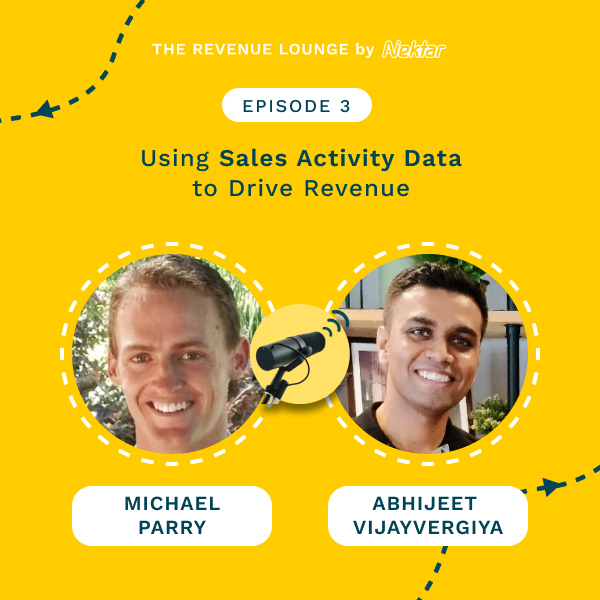
Ep #3: Using Activity Data to Drive Sales Productivity
Listen Now
Ep #4: Creating a Successful RevOps Roadmap
Listen Now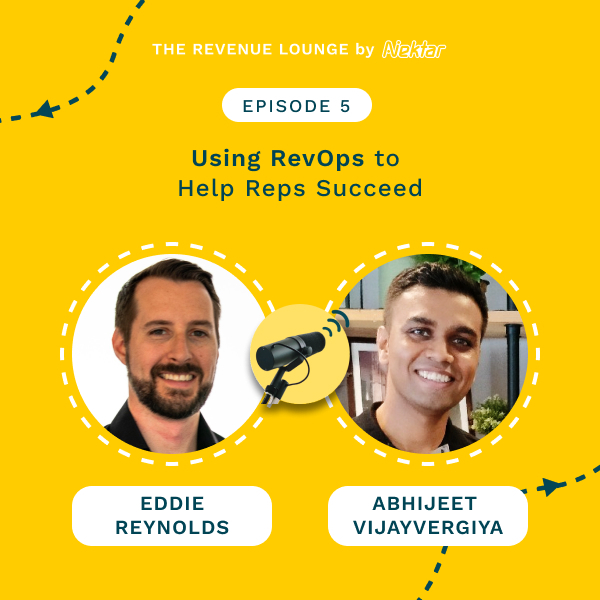
Ep #5: Using RevOps to Help Reps Succeed
Listen Now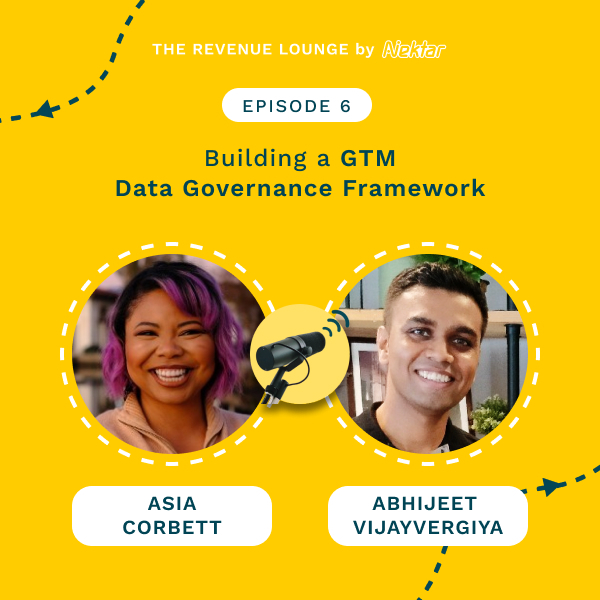
Ep #6: Building a GTM Data Governance Framework
Listen Now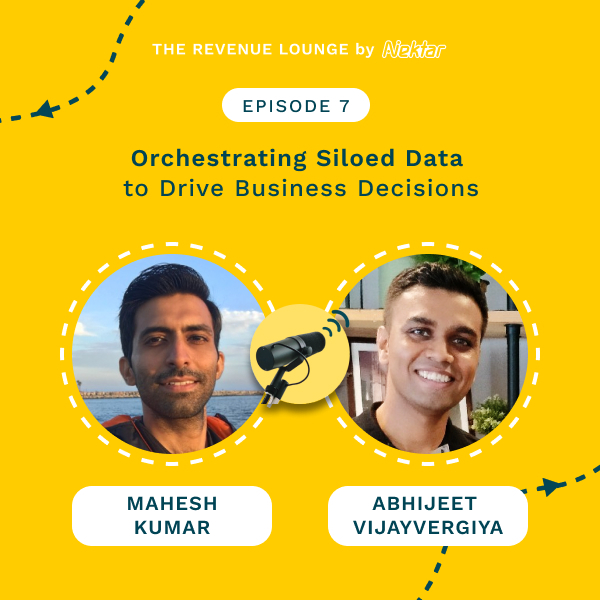
Ep #7: Orchestrating Siloed Data to Drive Business Decisions
Listen Now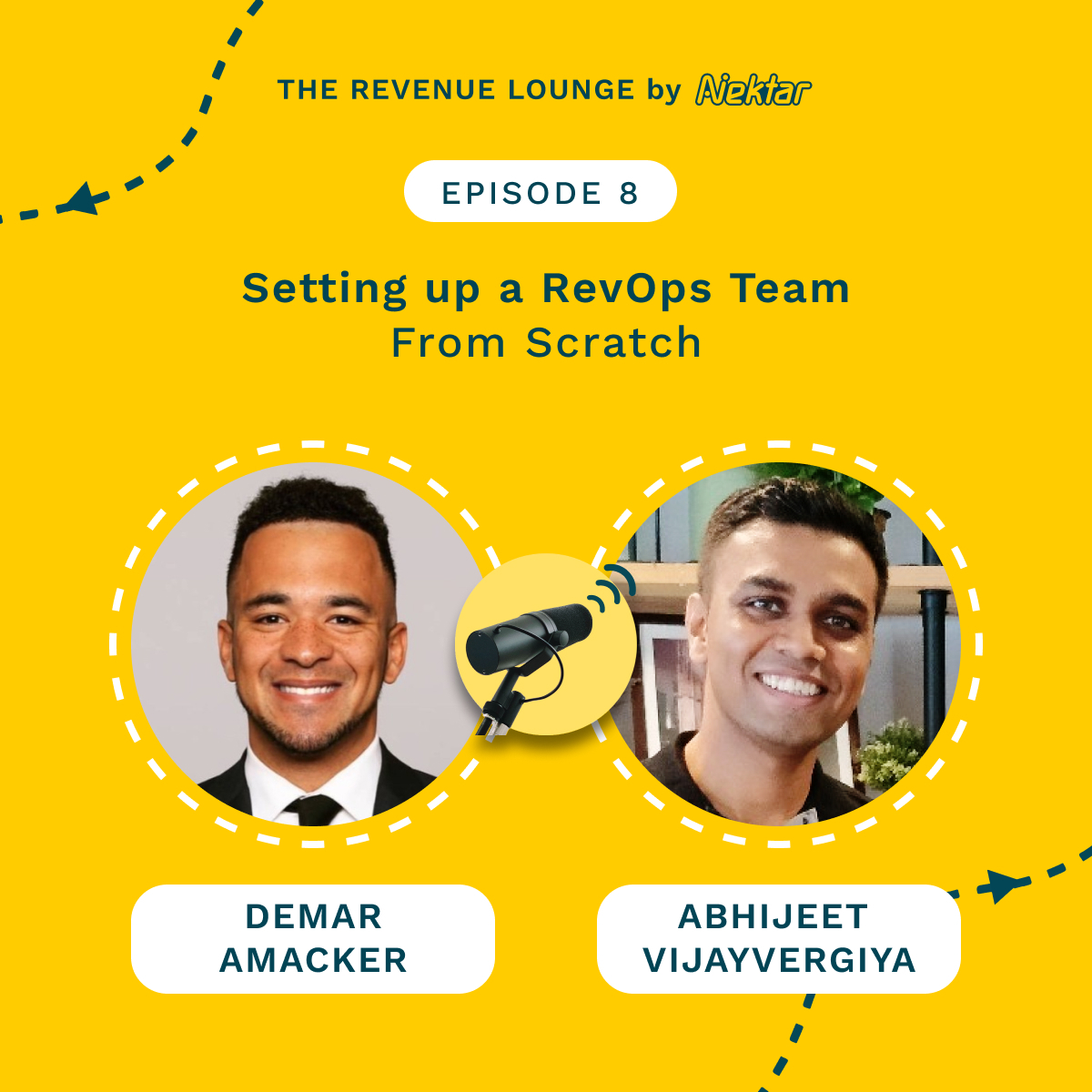
Ep #8: Setting Up a RevOps Team From Scratch
Listen Now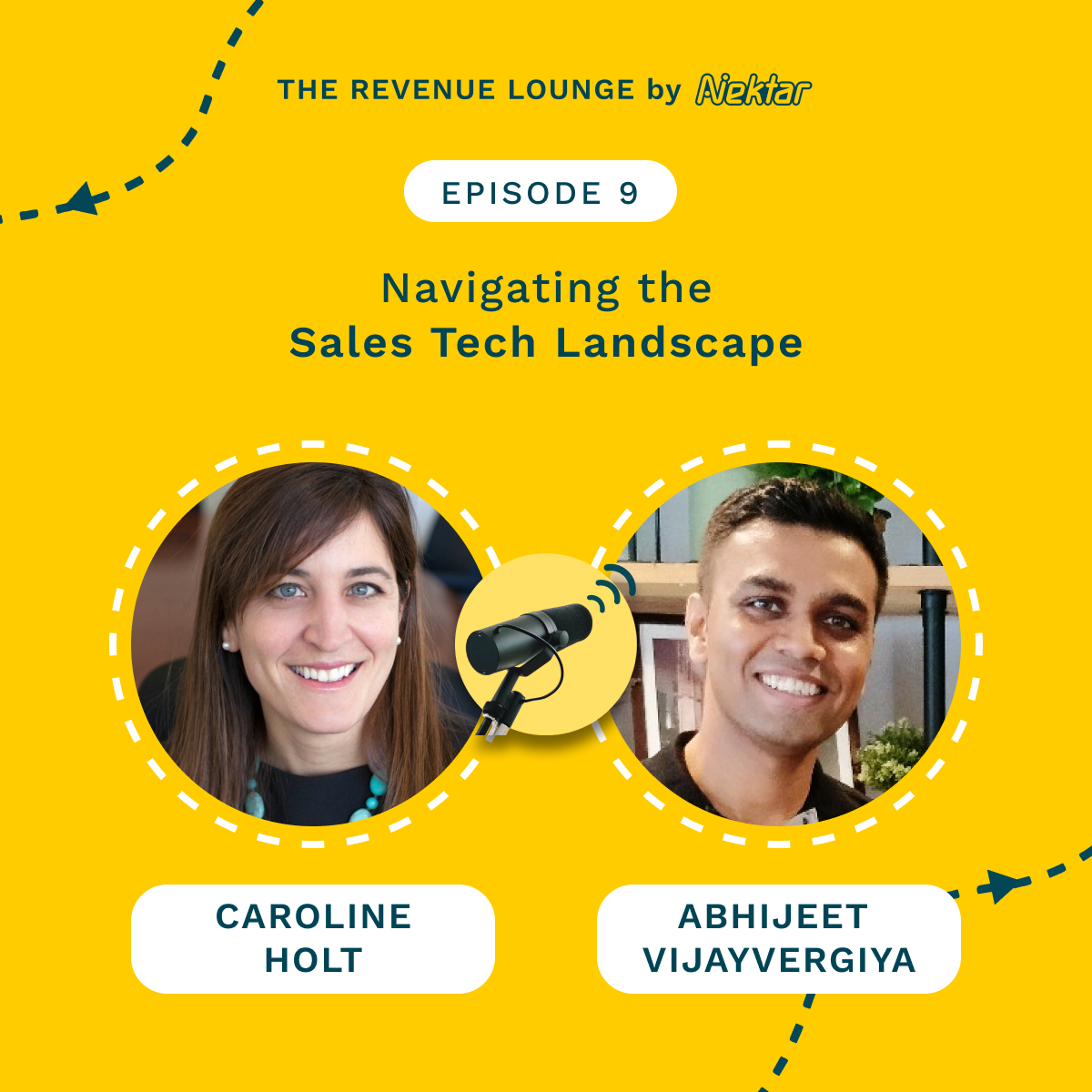
Ep #9: Navigating the Sales Tech Landscape
Listen Now